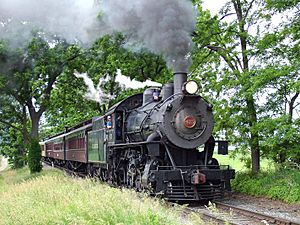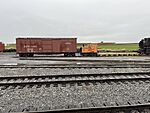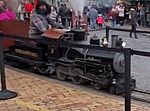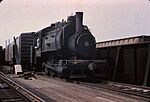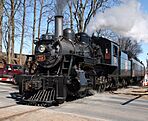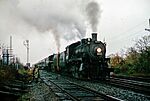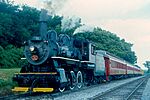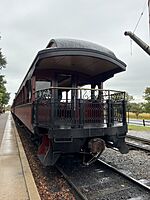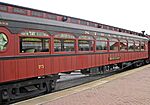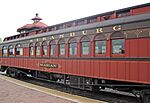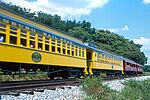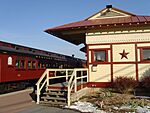Strasburg Rail Road facts for kids
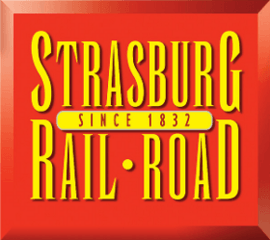 |
|
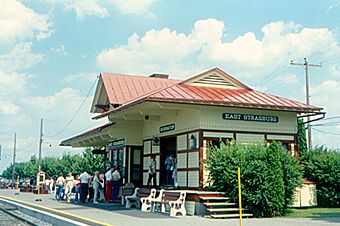
East Strasburg station in July 1979
|
|
| Overview | |
|---|---|
| Headquarters | Strasburg, Pennsylvania, U.S. |
| Reporting mark | SRC |
| Locale | Strasburg and Paradise Townships, Lancaster County, Pennsylvania |
| Dates of operation | 1832–present |
| Technical | |
| Track gauge | 4 ft 8 1⁄2 in (1,435 mm) standard gauge |
| Length | 4.02 mi (6.47 km) |
The Strasburg Rail Road is a special kind of train line called a heritage railroad. It's the oldest standard-gauge railroad in the Western Hemisphere that has been running non-stop. It's also the oldest public service company in Pennsylvania.
The railroad started in 1832. Today, it offers fun train rides pulled by steam locomotives. These rides cover about 4 miles (6.4 km) of track in a beautiful area called Pennsylvania Dutch Country. The Strasburg Rail Road also fixes trains for other companies and carries goods for businesses. Its main office is near Strasburg, Pennsylvania. About 300,000 people visit the railroad every year!
The Strasburg Rail Road is one of the few places in the U.S. where steam locomotives sometimes pull freight trains. The nearby Railroad Museum of Pennsylvania sometimes uses Strasburg tracks. This helps them connect to the main Amtrak line in Paradise.
Contents
History of the Strasburg Rail Road
Early Days: From Wagons to Rails
In the 1820s, canals were the main way to move goods. When the Susquehanna Canal opened, many goods went through Baltimore instead of Philadelphia. Philadelphia wanted to be a major port again. So, it built the Philadelphia and Columbia Railroad in 1831. Building a railroad was easier and cheaper than a canal.
This new railroad would go around Strasburg. This meant Strasburg might lose its important role in trade. So, some local business people asked the state government for permission. They wanted to build their own railroad to connect Strasburg to the new Philadelphia and Columbia line. On June 9, 1832, they got the official permission to start the Strasburg Rail Road.
First Trains and Changes Over Time
The Strasburg Rail Road was likely built by 1837. At first, horses pulled the trains! In 1851, the railroad bought its first steam locomotive. It was a used engine called the William Penn.
In 1863, a family named Herr bought most of the railroad. They also replaced the tracks with stronger ones for the steam engine. There were plans to make the railroad longer, but an economic problem in 1866 stopped that.
A big fire in 1871 destroyed many railroad buildings. The railroad was sold a few times after that. By 1918, State Senator John Homsher owned it. Around this time, fewer people rode the train. This was because streetcars offered a more direct way to travel between Lancaster and Strasburg.
Tough Times and a New Beginning
In 1926, the Strasburg Rail Road bought a small, gasoline-powered train called a switcher locomotive. This was the only train ever built just for the Strasburg Rail Road. By 1958, the railroad was having a very hard time. There wasn't much freight business, and a hurricane had caused damage.
When the owner, Bryson Homsher, passed away, his family wanted to close the railroad. But some railfans (people who love trains) from Lancaster stepped in. Henry K. Long and Donald E. L. Hallock formed a group to buy and save the railroad. They worked hard for almost a year. On November 1, 1958, they finally bought it! A week later, the railroad carried its first load of goods for a customer.
Becoming a Tourist Attraction
Fun train rides for tourists started on January 4, 1959. The first steam locomotive for these rides arrived in June of the next year.
Today, the train takes passengers on a 45-minute round trip. It goes from East Strasburg to Leaman Place Junction. The journey passes through beautiful farmland in Lancaster County. A part of each ticket helps support the Lancaster Farmland Trust.
The railroad has the only working wooden dining car in the United States. Visitors can eat a meal while riding! At the station, there are other fun things to do. You can ride a small steam train called the Pint-Sized Pufferbelly. There are also old-fashioned pump cars and "cranky cars" from the 1930s. Plus, there are gift shops and a cafe.
The railroad's shops are very important. They fix and restore locomotives and train cars for many different clients. These include other railroads, train museums, and even other big industries. The shops were made bigger in 2016–17 to handle more work.
The freight part of the railroad helps local businesses ship their goods. They connect with the Norfolk Southern Railway at Leaman Place Junction.
For a while, freight business was very slow. There were even years with no freight shipments at all. The railroad decided to actively look for new freight business in 2008. They improved the main track to handle heavier modern freight cars. They also bought a diesel locomotive, EMD SW8 #8618, for freight duties.
Since 2008, freight shipments have grown a lot. This led to a new $1.5 million facility for moving goods. They even bought another diesel locomotive, an EMD SW9, in 2019. In February 2023, the railroad opened a new six-track freight yard near U.S. 30.
Train Equipment
Locomotives (Engines)
The Strasburg Rail Road has many different types of locomotives. Here are some of them:
Passenger Cars
The Strasburg Rail Road has many different passenger cars, each with its own history and name.
Accidents and Incidents
- On September 4, 2014, an empty passenger car on an excursion train went off the tracks near the station. No one was hurt. This happened because of a small problem with one of the track switches. The crew quickly got the car back on the track.
- On November 2, 2022, locomotive No. 475 bumped into an excavator that was parked on a side track. This happened while the train was moving around to the other end of the passenger cars. The impact made a hole in the front of the locomotive. No one on the train was hurt, and the damage was not too serious. The accident was seen live online and recorded by a passenger. It was caused by a switch that was not in the correct position. The Federal Railroad Administration (FRA) looked into the accident. Repairs on No. 475 started the next day and were finished by November 7, when the locomotive returned to service.
Images for kids


